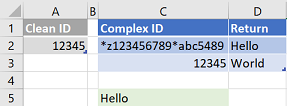Hi @Xin
Technically the method is still try to cleanse table B to "exact" match with table A, just wondering if there is any function that would perform "contain" search (i.e. sub text string of B matches A). Not sure if that would drag the performance by too much?
Any existing or custom function involving something like "contains" can not work. As an example, if TableA has [Clean ID] 12345 and somewhere in TableB a [Complex ID] is something like "123456789*abc5489", **12345 would be found in that [Complex ID] and what you want is an EXACT match
Just wondering I can see a fx-rephrase being added. Therefore I assume this is to cleanse the ID in table B before can be looked up?
Not sure where you found fx-rephrase in what I uploaded. The function I created was named fxParseComplexID. If that's what you talk about, then Yes that's what the function does, inside query UnMatchedComplexClean
I think it works well so far but just also thinking there are probably 10,20 different ways how column B ID can be presented therefore shall I just keep adding cleanse methods?
- I told you to upload at least 20 different and representative [Complex ID]. You did not, so I did with the few example you provided
- Sorry but I don't really understand, especially "shall I just keep adding cleanse methods". Please clarify



